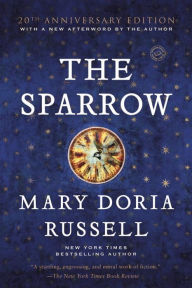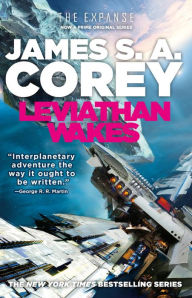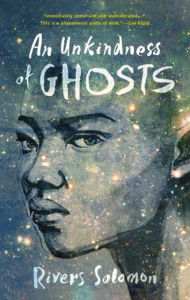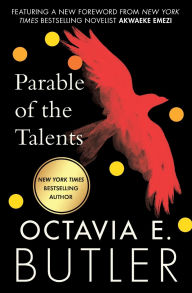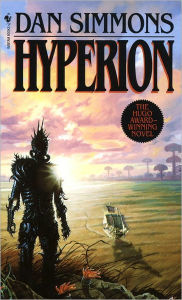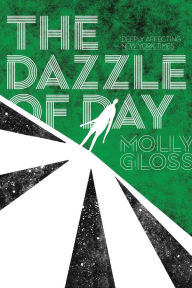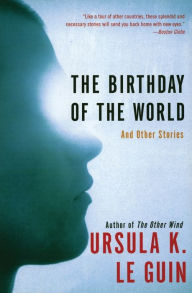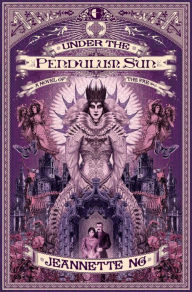10 Science Fiction Books Featuring Interplanetary Religious Missions
 The word “mission” has something of a triple meaning. A mission can be a group of people tasked with political, cultural, or scientific service; famously, the five-year mission of the starship Enterprise is to seek out new life and new civilizations. A mission can be military in nature: a covert excursion behind enemy lines. And a mission can be religious or spiritual: the marshaling of missionaries to the unknown and the alien in order to convert or instruct. This layering of possible meanings is a rich vein of inquiry for the science fiction writer, and can become even more fraught when the mission (military, religious, scientific, or all three) also includes a first contact scenario.
The word “mission” has something of a triple meaning. A mission can be a group of people tasked with political, cultural, or scientific service; famously, the five-year mission of the starship Enterprise is to seek out new life and new civilizations. A mission can be military in nature: a covert excursion behind enemy lines. And a mission can be religious or spiritual: the marshaling of missionaries to the unknown and the alien in order to convert or instruct. This layering of possible meanings is a rich vein of inquiry for the science fiction writer, and can become even more fraught when the mission (military, religious, scientific, or all three) also includes a first contact scenario.
Science fiction allows us to walk around historical events and people, play them out with different parameters and in extremis. The religious mission—with or without contact—transposed into the stars provides ample room in which to shape a story. Depending on the religion in question, the mission can be naïve or pious, compassionate or conquering, or a mixture of all of these attributes. The generation ship, the definitive long-haul interstellar vessel in universes without faster than light travel, is another place writers can play out the inevitable conclusions of a theology, for better or for worse—or both at once.
Here are 10 novels that detail religious missions to the stars—plus one bonus fantasy excursion. (Note: I’m not including novels about missions that feature religious members, but aren’t otherwise organized around religious principles.)
The Sparrow
The Sparrow
In Stock Online
Paperback $19.00
The Sparrow, by Maria Doria Russell
Russell makes the case that a religious mission will be the first to make contact with alien societies in the very prologue: “It was predictable, in hindsight,” read the opening lines. While the temporal governments of the world were debating could and should, the spiritual government in the Vatican had already decided to send priests off to a newly discovered, inhabited planet. The only questions were who and how. The story of the Jesuit mission to Rakhat that unfolds from this decision is as much a spiritual story as a science fictional one. The aliens’ biology and society are carefully constructed—the one arising from the other—and come into deep and abiding conflict with human biology and society. The motives of the people who mission to visit Rakhat aren’t necessarily pure, and things only get messier on the ground.
The Sparrow, by Maria Doria Russell
Russell makes the case that a religious mission will be the first to make contact with alien societies in the very prologue: “It was predictable, in hindsight,” read the opening lines. While the temporal governments of the world were debating could and should, the spiritual government in the Vatican had already decided to send priests off to a newly discovered, inhabited planet. The only questions were who and how. The story of the Jesuit mission to Rakhat that unfolds from this decision is as much a spiritual story as a science fictional one. The aliens’ biology and society are carefully constructed—the one arising from the other—and come into deep and abiding conflict with human biology and society. The motives of the people who mission to visit Rakhat aren’t necessarily pure, and things only get messier on the ground.
Leviathan Wakes (Expanse Series #1)
Leviathan Wakes (Expanse Series #1)
In Stock Online
Paperback
$16.99
$19.99
Leviathan Wakes, by James S.A. Corey
When the principle characters of the opening volume of The Expanse first see the Mormon generation ship Nauvoo in the shipyards of Tycho station, they are awed by its sheer size. While the Nauvoo is not central to the plot—its utility has more to do with its enormously powerful engines—it is clear, through cross-chatter between characters, that the Nauvoo is the first (and possibly only) generation ship under construction in the solar system, an effort undertaken by the LDS Church that is “headed for the stars and freedom from procreation restrictions.” Like The Sparrow, the religious of this fractured solar system are the first to strike for the stars, because they have the organization and the drive to do so.
Leviathan Wakes, by James S.A. Corey
When the principle characters of the opening volume of The Expanse first see the Mormon generation ship Nauvoo in the shipyards of Tycho station, they are awed by its sheer size. While the Nauvoo is not central to the plot—its utility has more to do with its enormously powerful engines—it is clear, through cross-chatter between characters, that the Nauvoo is the first (and possibly only) generation ship under construction in the solar system, an effort undertaken by the LDS Church that is “headed for the stars and freedom from procreation restrictions.” Like The Sparrow, the religious of this fractured solar system are the first to strike for the stars, because they have the organization and the drive to do so.
An Unkindness of Ghosts
An Unkindness of Ghosts
In Stock Online
Paperback $15.95
An Unkindness of Ghosts, by Rivers Solomon
The religious mandate of the Matilda, the generation ship which serves as canvass for An Unkindness of Ghosts, is fairly diffuse, though inextricably bound up in its power structures. A cataclysm sent what might be humanity’s last remnants into space centuries ago, launching the Matilda towards the Promised Land. Whatever the motivations of the people who launched it, the vessel is now an autocracy ruled by systematic racism and a pliable religious fundamentalism. For every religious figure who argued against slavery, that many and more argued for its righteousness in the antebellum South; so too on the Matilda. Religion is just one aspect of systematic oppression, a promised land that recedes, out in the void, unreachable.
An Unkindness of Ghosts, by Rivers Solomon
The religious mandate of the Matilda, the generation ship which serves as canvass for An Unkindness of Ghosts, is fairly diffuse, though inextricably bound up in its power structures. A cataclysm sent what might be humanity’s last remnants into space centuries ago, launching the Matilda towards the Promised Land. Whatever the motivations of the people who launched it, the vessel is now an autocracy ruled by systematic racism and a pliable religious fundamentalism. For every religious figure who argued against slavery, that many and more argued for its righteousness in the antebellum South; so too on the Matilda. Religion is just one aspect of systematic oppression, a promised land that recedes, out in the void, unreachable.
The Book of Strange New Things
The Book of Strange New Things
By Michel Faber
In Stock Online
Paperback $23.00
The Book of Strange New Things, by Michel Faber
Pastor Peter Leigh leaves behind a dying earth and his wife Beatrice to minister to the aliens of a planet called Oasis. Oasis is administered (“we do not use the word ‘colony’”) by a sketchy corporation called USIC (the exact basis for the acronym is unknown). A part of the novel is epistolary: the conversation across the void between husband and wife, as they try to maintain a connection in their disconnected places. The Oasans are extremely receptive to Peter’s ministry—they were the ones who requested a missionary; nonetheless, Oasis begins to wear on Peter, both its wonder and its strangeness. The Oasans never quite respond to his theology as expected; meanwhile, Beatrice is being tested in her own way in the once familiar strangeness of earth seen from space. The novel’s title is what the aliens call the bible, and provides is a way toward understanding the events that unfold.
The Book of Strange New Things, by Michel Faber
Pastor Peter Leigh leaves behind a dying earth and his wife Beatrice to minister to the aliens of a planet called Oasis. Oasis is administered (“we do not use the word ‘colony’”) by a sketchy corporation called USIC (the exact basis for the acronym is unknown). A part of the novel is epistolary: the conversation across the void between husband and wife, as they try to maintain a connection in their disconnected places. The Oasans are extremely receptive to Peter’s ministry—they were the ones who requested a missionary; nonetheless, Oasis begins to wear on Peter, both its wonder and its strangeness. The Oasans never quite respond to his theology as expected; meanwhile, Beatrice is being tested in her own way in the once familiar strangeness of earth seen from space. The novel’s title is what the aliens call the bible, and provides is a way toward understanding the events that unfold.
Parable of the Talents
Parable of the Talents
In Stock Online
Paperback $19.99
Parable of the Talents, by Octavia Butler
Neither Parable of the Talents nor its predecessor, Parable of the Sower, details a religious mission to the stars. Instead, they tell the origin story of a woman named Lauren Olamina and share the cultural, personal, and historical underpinnings of Earthseed, the religion she founds. One of Earthseed’s central tenants is that people must leave Earth and settle on other planets in order for humanity to mature. In Parable of the Talents, Acorn, the small religious community Lauren leads, is imprisoned by “Crusaders” for the US government, now run by Christian fundamentalists. The adults are forced into slavery due to their religion; their children, including Lauren’s daughter, are sent to be fostered by proper Christians. Lauren’s commitment to her religion sees her through these dark times, though she never recovers her daughter. In the end, Lauren is present to witness the launch of the Christopher Columbus, a ship bound for Alpha Centauri filled with adherents of Earthseed. Parable of the Talents is the second in what was planned to be a trilogy, but Butler died before she could complete it. The third novel was to detail the colonists’ lives on the new planet. Alas.
Parable of the Talents, by Octavia Butler
Neither Parable of the Talents nor its predecessor, Parable of the Sower, details a religious mission to the stars. Instead, they tell the origin story of a woman named Lauren Olamina and share the cultural, personal, and historical underpinnings of Earthseed, the religion she founds. One of Earthseed’s central tenants is that people must leave Earth and settle on other planets in order for humanity to mature. In Parable of the Talents, Acorn, the small religious community Lauren leads, is imprisoned by “Crusaders” for the US government, now run by Christian fundamentalists. The adults are forced into slavery due to their religion; their children, including Lauren’s daughter, are sent to be fostered by proper Christians. Lauren’s commitment to her religion sees her through these dark times, though she never recovers her daughter. In the end, Lauren is present to witness the launch of the Christopher Columbus, a ship bound for Alpha Centauri filled with adherents of Earthseed. Parable of the Talents is the second in what was planned to be a trilogy, but Butler died before she could complete it. The third novel was to detail the colonists’ lives on the new planet. Alas.
Planetfall
Planetfall
By Emma Newman
In Stock Online
Paperback $22.00
Planetfall, by Emma Newman
Like Parable of the Talents, the faithful travelers in Planetfall are members of a faith invented for the novel, one which holds the colonization of or pilgrimage to other worlds as a central tenant. At the opening, we are introduced to a colony of people who have been living at the base of an enormous, seemingly engineered alien structure they call “God’s City” for about 20 years. They are all pilgrims who followed the charismatic Lee Suh-Mi to this alien planet, at which point she promptly vanished into God’s City. They have been waiting for her return ever since. When Suh-Mi’s grandson, whom no one knew existed, one day walks out of the wilderness, the quasi-utopian community begins to unravel as the secrets of its origins and Suh-Mi’s disappearance come to light. The faith they afforded their leaders was something between misplaced and actively buried.
Planetfall, by Emma Newman
Like Parable of the Talents, the faithful travelers in Planetfall are members of a faith invented for the novel, one which holds the colonization of or pilgrimage to other worlds as a central tenant. At the opening, we are introduced to a colony of people who have been living at the base of an enormous, seemingly engineered alien structure they call “God’s City” for about 20 years. They are all pilgrims who followed the charismatic Lee Suh-Mi to this alien planet, at which point she promptly vanished into God’s City. They have been waiting for her return ever since. When Suh-Mi’s grandson, whom no one knew existed, one day walks out of the wilderness, the quasi-utopian community begins to unravel as the secrets of its origins and Suh-Mi’s disappearance come to light. The faith they afforded their leaders was something between misplaced and actively buried.
Hyperion (Hyperion Series #1)
Hyperion (Hyperion Series #1)
By Dan Simmons
In Stock Online
Paperback $11.00
Hyperion, by Dan Simmons
The structure of Hyperion is based on the The Canterbury Tales, that middle school medieval classic: people on pilgrimage tell each other tales (the kind which define their place in the world) on their way to a religious shine. In Hyperion, however, those pilgrims were all chosen by the godless artificial intelligences of the TechnoCore to journey to the planet Hyperion, holy land of the Church of Final Atonement, which worships an inscrutable and often antagonistic being known as the Shrike. The backdrop of these stories is the kind of galaxy-spanning space operatics that are not easily summed in a sentence or two (though one of them, a priest, shares a story of fractured faith that will chill you to your bones). Indeed, like The Canterbury Tales (or the lesser known but more fun Decameron), the individual stories build a whole world—whole worlds—in tight, personal narratives. What’s interesting here is that the pilgrimage isn’t so much spiritual as martial.
Hyperion, by Dan Simmons
The structure of Hyperion is based on the The Canterbury Tales, that middle school medieval classic: people on pilgrimage tell each other tales (the kind which define their place in the world) on their way to a religious shine. In Hyperion, however, those pilgrims were all chosen by the godless artificial intelligences of the TechnoCore to journey to the planet Hyperion, holy land of the Church of Final Atonement, which worships an inscrutable and often antagonistic being known as the Shrike. The backdrop of these stories is the kind of galaxy-spanning space operatics that are not easily summed in a sentence or two (though one of them, a priest, shares a story of fractured faith that will chill you to your bones). Indeed, like The Canterbury Tales (or the lesser known but more fun Decameron), the individual stories build a whole world—whole worlds—in tight, personal narratives. What’s interesting here is that the pilgrimage isn’t so much spiritual as martial.
Starglass (Starglass Sequence Series #1)
Starglass (Starglass Sequence Series #1)
By Phoebe North
In Stock Online
Paperback $12.99
Starglass, by Phoebe North
Starglass takes place on the generation ship Asherah, which left Earth 500 years earlier, after an asteroid struck the planet. The Asherah’s original occupants were secular Jews, but in the intervening centuries the religious practice has become traditionalist and rigid. Terra Fineberg’s family is anomalous on a ship where social structures are tightly mandated: all people will marry and have two children, a boy and a girl. But Terra’s mother died of cancer (the first case in centuries), so it is just her grief-broken father and her. The Asherah is mere months from its destination planet when Terra witnesses the captain’s guard murder an innocent man, an event that wakes Terra up to the resentments and power struggles playing out under the rigidly regimented surface of her society. The growing rigidity of religious structures in a locked room environment is a common theme in stories about interstellar missions; Starglass shows how that can unravel once the ship gets where it is going.
Starglass, by Phoebe North
Starglass takes place on the generation ship Asherah, which left Earth 500 years earlier, after an asteroid struck the planet. The Asherah’s original occupants were secular Jews, but in the intervening centuries the religious practice has become traditionalist and rigid. Terra Fineberg’s family is anomalous on a ship where social structures are tightly mandated: all people will marry and have two children, a boy and a girl. But Terra’s mother died of cancer (the first case in centuries), so it is just her grief-broken father and her. The Asherah is mere months from its destination planet when Terra witnesses the captain’s guard murder an innocent man, an event that wakes Terra up to the resentments and power struggles playing out under the rigidly regimented surface of her society. The growing rigidity of religious structures in a locked room environment is a common theme in stories about interstellar missions; Starglass shows how that can unravel once the ship gets where it is going.
The Dazzle of Day
The Dazzle of Day
By Molly Gloss
In Stock Online
Paperback $15.99
The Dazzle of Day, by Molly Gloss
The Dazzle of Day takes place largely on a generation ship after it has reached its target planet, circling above and deciding whether to set down or move onto the next possible destination. The original people of the ship were Quakers, and the ethos of that denomination pervades the culture of the ship: the reliance on consensus over majority rule, the unstructured and often silent meeting style. The events of several months are told in a chain of linked perspectives, perspectives as much trained on the large questions as the small. Dazzle of Day is a quiet, contemplative novel, as befits the practice of the people at its center.
The Dazzle of Day, by Molly Gloss
The Dazzle of Day takes place largely on a generation ship after it has reached its target planet, circling above and deciding whether to set down or move onto the next possible destination. The original people of the ship were Quakers, and the ethos of that denomination pervades the culture of the ship: the reliance on consensus over majority rule, the unstructured and often silent meeting style. The events of several months are told in a chain of linked perspectives, perspectives as much trained on the large questions as the small. Dazzle of Day is a quiet, contemplative novel, as befits the practice of the people at its center.
The Birthday of the World: And Other Stories
The Birthday of the World: And Other Stories
In Stock Online
Paperback $18.99
“Paradises Lost” by Ursula K. Le Guin
“Paradises Lost,” a novella originally published in The Birthday of the World, takes place on a long-haul ship five generations removed from Earth and slowly decelerating toward its target planet. Though the original inhabitants of the ship took measures to impede such an eventuality, a religion has sprouted up in the years since the ship launched: Bliss, whose adherents are known as angels. The disciples of Bliss do not think of anything outside the ship as real; its is only the journey that matters, not the destination. As the ship nears the planet—something kept from the angels until contact was nearly unavoidable—its population is faced with a dilemma: to set down, or to continue on within their hermetically sealed world. Like many of Le Guin’s works, “Paradises Lost” deals with near-utopias and their fractures, cultural structures and their dark sides, the unreal and the real.
“Paradises Lost” by Ursula K. Le Guin
“Paradises Lost,” a novella originally published in The Birthday of the World, takes place on a long-haul ship five generations removed from Earth and slowly decelerating toward its target planet. Though the original inhabitants of the ship took measures to impede such an eventuality, a religion has sprouted up in the years since the ship launched: Bliss, whose adherents are known as angels. The disciples of Bliss do not think of anything outside the ship as real; its is only the journey that matters, not the destination. As the ship nears the planet—something kept from the angels until contact was nearly unavoidable—its population is faced with a dilemma: to set down, or to continue on within their hermetically sealed world. Like many of Le Guin’s works, “Paradises Lost” deals with near-utopias and their fractures, cultural structures and their dark sides, the unreal and the real.
Special bonus: fantasy missionaries!
Under the Pendulum Sun
Under the Pendulum Sun
By Jeannette Ng
In Stock Online
Paperback $14.99
Under the Pendulum Sun, by Jeannette Ng
Under the Pendulum Sun follows a missionary’s sister, Catherine, into the Faelands of Acadia, where her brother Laon has gone to convert the fae. After a wonderful and strange passage through Acadia – —a place that can only be entered by the lost—Catherine finds the mission empty but for its fae staff. Maybe it’s because British fairy lore is already intertwined with Christianity (the Unseelie court, for example, is understood to be in league with the devil, while the Seelie is … kind of not), but I’ve never before seen a story in which Christian missionaries attempt to convert the Good Folk. The Faelands and its inhabitants in Under the Pendulum Sun try Laon and Catherine’s Victorian theology: these are not just the (already difficult) cultural differences between humans, but profound ontological ones as well. For a theology based at least partially on Natural Theology, the very structure of the Faelands—with its titular pendulum sun—puts the lie to religious arguments based on perceived divine design. There may be a Watchmaker of the Faelands, but whether that creator is divine is a whole other issue.
Under the Pendulum Sun, by Jeannette Ng
Under the Pendulum Sun follows a missionary’s sister, Catherine, into the Faelands of Acadia, where her brother Laon has gone to convert the fae. After a wonderful and strange passage through Acadia – —a place that can only be entered by the lost—Catherine finds the mission empty but for its fae staff. Maybe it’s because British fairy lore is already intertwined with Christianity (the Unseelie court, for example, is understood to be in league with the devil, while the Seelie is … kind of not), but I’ve never before seen a story in which Christian missionaries attempt to convert the Good Folk. The Faelands and its inhabitants in Under the Pendulum Sun try Laon and Catherine’s Victorian theology: these are not just the (already difficult) cultural differences between humans, but profound ontological ones as well. For a theology based at least partially on Natural Theology, the very structure of the Faelands—with its titular pendulum sun—puts the lie to religious arguments based on perceived divine design. There may be a Watchmaker of the Faelands, but whether that creator is divine is a whole other issue.
